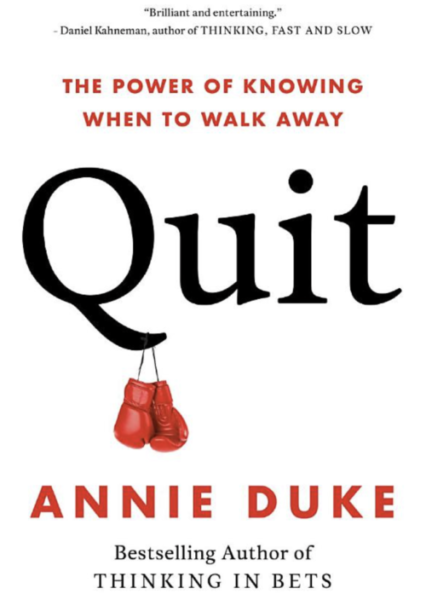“QUIT” by Annie Duke is an extraordinary book by an extraordinarily practical author who thinks like an actuary

I have had my copy of Quit marked up and ready to review for a couple of months now– almost since the day it arrived from Amazon shortly after it was published last fall. I have waited until now to write this review in order to fully absorb all the insights that Annie Duke has provided in the latest, and to my mind, best of her books on making decisions under uncertainty.
Ms. Duke is not an actuary, but her thinking and approach to risk mitigation and management will be entirely familiar to those of us who look at such questions through the lens of actuarial science. This book is a follow-up to her bestselling books Thinking in Bets and How to Decide. Unlike those two books, which discuss the general problem of choice under uncertainty. Quit addresses a single and extremely important aspect of risk assessment that is often in the background of our struggles with the choices that we face in life. This book essentially provides guidance on when to answer “none of the above” to multiple-choice questions that appear to have only a few specific alternative answers to choose from.
 Before I continue, I need to disclose that I am biased regarding all I say about Quit and Annie Duke’s writing.
Before I continue, I need to disclose that I am biased regarding all I say about Quit and Annie Duke’s writing.
Annie was kind enough to write the foreword to my recent book Money Mountaineering, but just because I am biased doesn’t mean that what I am saying is wrong. It does mean, however, that, like all information you get from virtually anywhere, you should consider the perspective of the individual who is providing it. In this case, I think my bias helps because I have worked with Annie, know her work well, and have come to the conclusion that it is work that deserves to be widely read and appreciated
In my opinion, this is a great book and while technically sophisticated enough to satisfy most actuaries, it is also both easy and entertaining to read as well. Even better, Quit provides a great deal of practical advice for almost anyone who struggles with important life choices. This book will help people get better at making all kinds of decisions, including “knowing when to hold ‘em and when to fold ‘em”.
This and the many other gambling metaphors that Annie employs throughout the book will not surprise anyone familiar with her life story which includes 20 years as a professional poker player. Annie is one of the most successful women poker players in history, having collected over $4 million in winnings while playing against some of the best players in the world.
While much of what she writes is based on Annie’s very solid understanding of probability, statistics and the theory of interest to evaluate the present value of alternative scenarios, what sets this book apart is Annie’s acumen as a cognitive psychologist. She earned a Master’s degree in that field from the University of Pennsylvania but decided to quit just short of becoming a Ph.D. This story is told in Quit and provides yet another illustration of how and when to decide to stop doing what you are doing and find another plan. I found Annie’s personal story to be one of the highlights of the book as it provides a rare opportunity for the reader to get to know the author and how she thinks when focusing on her own life choices. I, for one, find it much more impactful when an expert tells me not what they recommend I do but rather what they themselves have done when facing decisions that are similar to my own.
Perhaps the best reason to read this book, however, is to hear Annie’s understanding and practical advice regarding the cognitive errors and biases that we are all prone to as human beings. For example, in one of the extremely helpful summaries she includes at the end of each chapter, Annie notes that “Thinking in expected value helps you figure out if the path you are on is worth sticking to ……if you feel like the choice between persevering and walking away is a close call, it is likely that quitting is the better choice.”
As actuaries, we have our own techniques for addressing the “noise” that arises in both the data we analyze and in the minds of ourselves and our clients stemming from the cognitive errors and emotional bias that we are all prone to. It is to our profession’s credit that we are beginning to study Bias itself as a subject of actuarial analysis, but in my opinion, books like Annie’s can provide a provisional path through the confusion and lack of quantifiability that often attends our attempts to help our clients navigate through what I think of as the Financial Wilderness that comprises the world of Time, Risk and Money. It is a world in which we, as actuaries, are trained to live comfortably, but it is also a world where many people find themselves lost and uncertain about which path to follow each time they come to a fork in the road.
Beyond the pointers she provides at the end of each chapter, Annie also discusses deep and largely unsolved problems related to quitting that actuaries and mathematicians have struggled with for centuries – e.g. “the Gambler’s Ruin problem,” determining “Kill Criteria” and the very important “Explore vs. Exploit” question.
In addressing this last question, Annie provides a brilliant real-life example of how a particular non-human species (ants) successfully attacks this issue. In this example, she describes how ants find and collect food to sustain their entire colony – with the majority of the ants forming a long line of “exploiters” walking to the identified food source, each carrying its load back to the nest, where it is stored and consumed to nourish the community. A minority of the ants, however, continue to serve as “explorers,” wandering around the vicinity searching for other sources of food that can feed the colony when the first source is exhausted or becomes suddenly unavailable. How many ants are designated as explorers and how many as exploiters is situation-dependent, but Annie’s key insight is that the exploit/explore problem is not just a search or resource allocation/optimization problem. Rather, the ants also have to make difficult decisions regarding when to stop exploiting and devote more resources to exploration, recognizing that waiting until the food runs out could doom the colony to starvation if alternative sources of food are not found in time while quitting too soon risks creating “stranded surplus” — a concept most pension actuaries are painfully familiar with. Annie doesn’t attempt to describe the problem mathematically but rather describes her observations regarding what has proven successful and what has not — for ants and for humans in situations more familiar to all of us.
In addition to illustrating how practice, using trial and error, is often a better way to find practical (approximate) solutions to problems that can’t be solved directly with mathematics, her ant colony example also illustrates that many decision and risk management problems are best approached collaboratively from many different angles simultaneously.
In short, I believe that Annie Duke’s perspective on problems that our profession faces and continues to deal with is well worth considering. Her book provides a wealth of important lessons for actuaries and non-actuaries alike.
